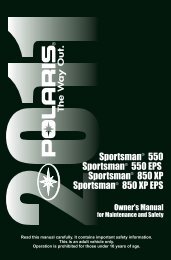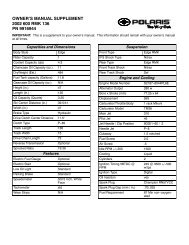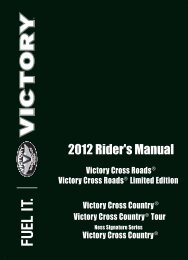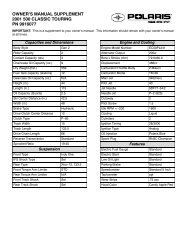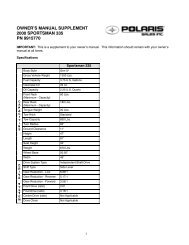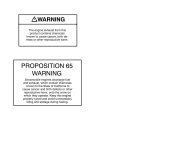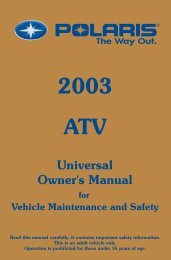V92TC V92TC DELUXE - Polaris
V92TC V92TC DELUXE - Polaris
V92TC V92TC DELUXE - Polaris
Create successful ePaper yourself
Turn your PDF publications into a flip-book with our unique Google optimized e-Paper software.
Safety Precautions<br />
Safe Riding Practices (continued)<br />
S If in doubt, reduce your speed when:<br />
- The weather is windy, raining, or otherwise causing slippery or rapidly changing conditions.<br />
- The traffic is heavy, congested, not allowing sufficient space between vehicles, or otherwise not<br />
flowing smoothly.<br />
- You are being passed in either direction by a large vehicle that produces a wind blast in its wake.<br />
S To maximize braking effectiveness, use the front and rear brakes together. Be aware of the following<br />
braking facts and practices:<br />
- The rear brake provides 40% of the motorcycle’s stopping power, at most.<br />
- Consider road conditions before applying the brakes; when the road is wet, rough, or contains loose<br />
or other slippery substances, apply the brakes gradually.<br />
- Bring the motorcycle to the upright position before applying the brakes, and avoid applying the<br />
brakes in a corner if at all possible. When the motorcycle is leaning through a corner, the amount of<br />
traction available for braking is reduced, increasing the possibility of the tires skidding when you<br />
apply the brakes.<br />
- Improper braking may cause you to lose control of the motorcycle or may not slow you in time to<br />
avoid a collision.<br />
S As you approach a curve, choose a speed and a lean angle that allow you to pass through the curve in<br />
your own lane without applying the brakes. Excessive speed, improper lean angle, or braking in a curve<br />
can cause you to lose control of the motorcycle.<br />
7



